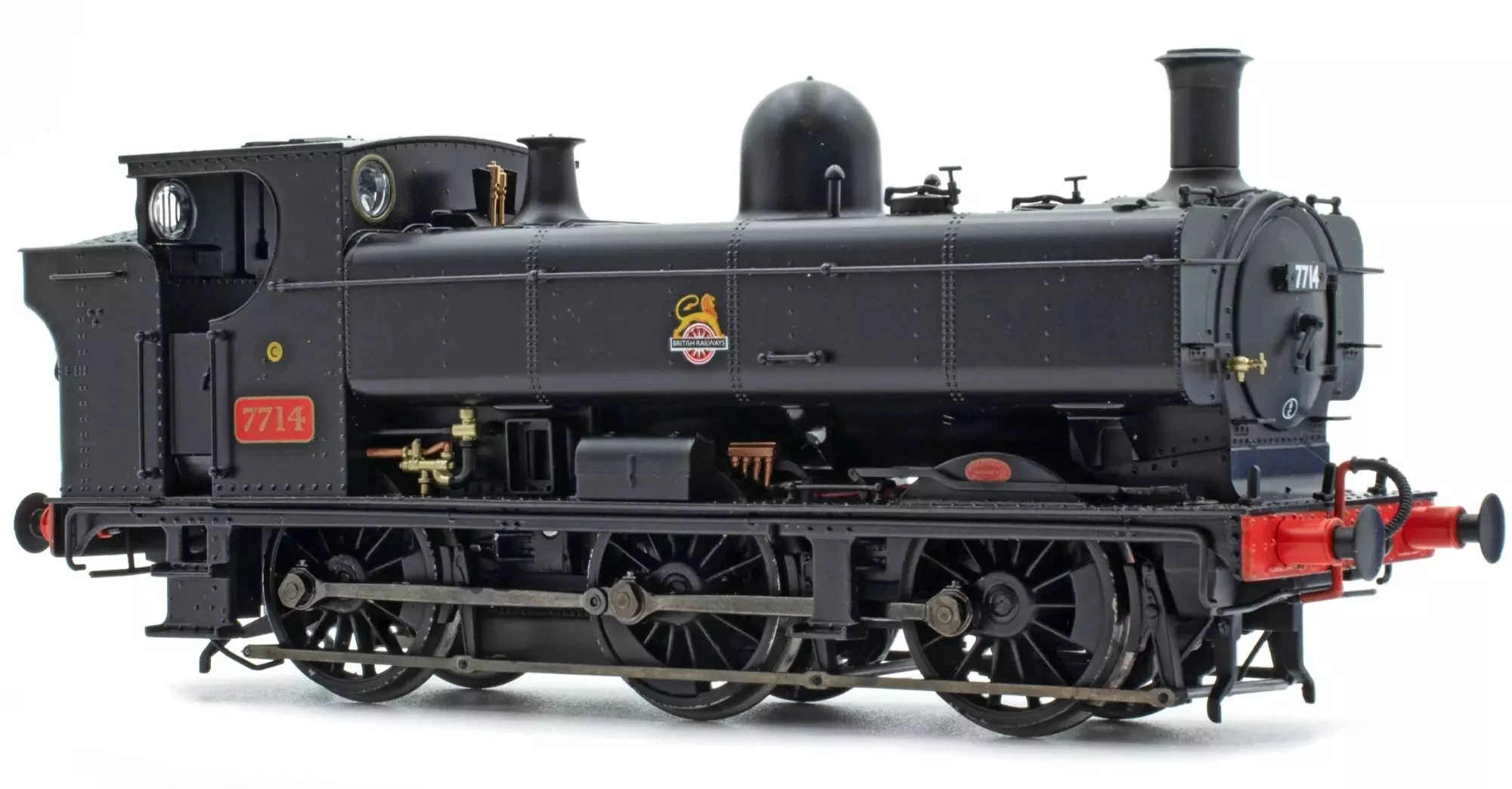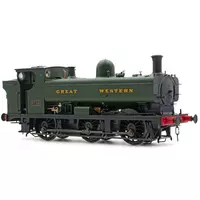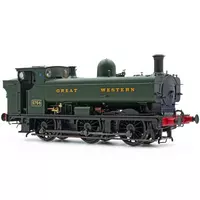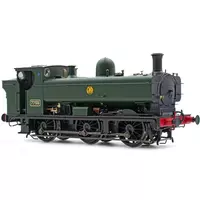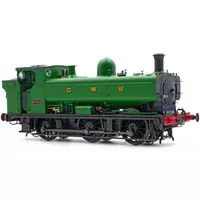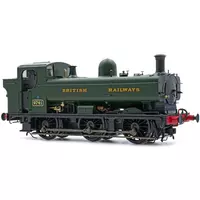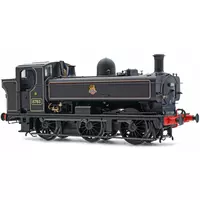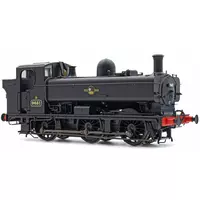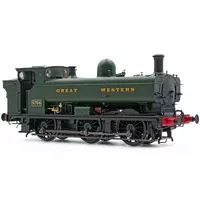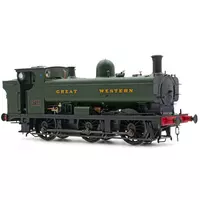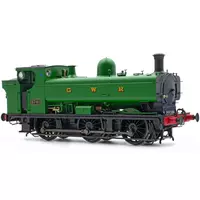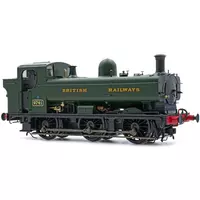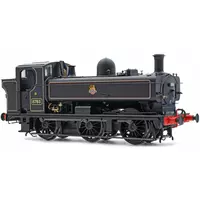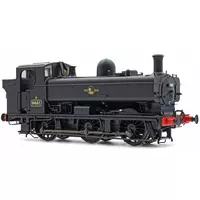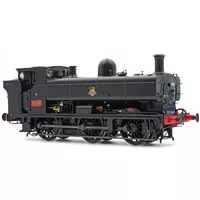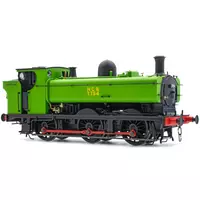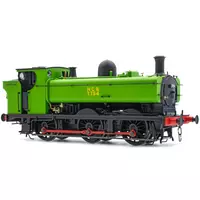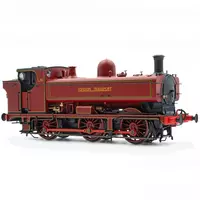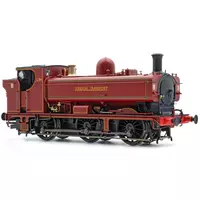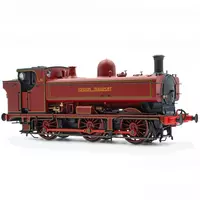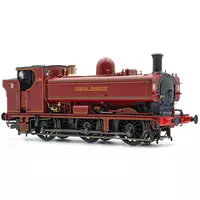Manufacturer catalogue image - please note that pre-release images may be CAD renders or CGI images rather than photographs
Prototype Era
Era 4 (1948 to 1956) British Railways Early Crest
Manufacturer description
Detailed Specification:
- Highly detailed 0-6-0PT 00 gauge model, 1:76.2 scale on 16.5mm track
- Minimum Radius 438mm (2nd radius set track)
- RP25-110 profile 00 gauge wheels
- Coreless motor with flywheel geared for maximum performance and slow speed running
- Die-cast metal chassis and pickups to all wheels.
- Next18 DCC ready or ESU LokSound V5 sound fitted, slot mounted in smokebox
- PowerPack capacitor for uninterrupted power
- Two quality sugar cube speakers contained in sound capsule located for best possible sound.
- Small, flexible neck NEM coupler mounts set at correct height, with mini-tension-lock couplers.
- Brake rigging factory fitted
- Brake blocks aligned with wheels
- Scale width wire handrails and sand pipes
- Fully detailed cab interior with twin LED pulsing/steady Firebox glow
- Etched metal/plastic detail parts, including grab handles, steps, buffer pipework, lamp irons etc.
- Turned brass whistles etched whistle shields (where fitted)
- Sliding roof ventilator
- Etched metal pre-painted number plates and works plates.
- Fully sprung metal buffers, factory-installed pipework and screw/3 link couplings
- Magnetically removable smoke box door
57xx History
The pannier tank story starts in the early part of the 1900s when the Great Western Railway began to replace the round topped fireboxes on some of its older locomotives with more efficient Belpaire fireboxes. The Belpaire firebox is a square design and gives improved heat transfer from the fire to the water in the boiler. However, fitting a saddle tank over the top of such a design would prove unnecessarily difficult. Other railways had adopted side tanks in place of earlier saddle tanks, the tanks extending all the way down to the footplate. This is great for stability and water capacity but not so good when it comes to servicing the inside workings of a steam locomotive. The pannier tank was deemed to be a better all round decision and this was adopted as standard for almost all GWR 0-6-0 locomotives going forward. Rebuilds continued various elderly classes of locomotive right up to (and past) grouping in 1923, which brought a vast array of different designs of locomotive from 28 acquired companies. This created a nightmare for maintenance, crew training and rostering. A standard locomotive would be the answer.
Concept and early orders
What was required was a standard, go-anywhere lightweight yet powerful tank locomotive. One that everyone could be familiar with that’s easy to maintain and handle. The design drew from many now standard GWR feature;, Belpaire boiler, inside cylinders driven by Stephenson’s valve gear, enclosed cab and most notably, pannier tanks. From the design office of Charles B Collett, 100 locomotives were ordered. These were developed from the earlier rebuilt 2721 class and were designated the 5700 class. Of the first hundred locomotives, fifty were built by the North British Locomotive Company in Glasgow (at both Hyde Park and Queens Park works) and fifty were built in the Great Western’s own workshops at Swindon. Almost immediately a further 200 locomotives were ordered, funded for by the British government as part of a work creation scheme. They 200 locomotives were split between 6 contractors: North British (50), Bagnall (50), Beyer-Peacock (25), Kerr-Stuart (25), Armstrong Whitworth (25) and Yorkshire Engine Co. (25). These 300 locomotives mostly formed class 5700 and became the standard pannier tank on the Great Western railway.
However, even though they were designed as a standard concept, they still shared many differences. A total of 50 locomotives were built without steam heat, Vacuum braking and GWR ATC – This formed class 6700 and were used primarily for shunting and short trip freight work and as such weren’t equipped with screw couplings either, a simple 3 link chain was hung from the coupling hooks.
Later Orders
The larger and more comfortable cab on the 9700 class was incorporated into the latest breed of pannier tank. From 1933 the 8750 class was born. Nearly 500 locomotives followed to this basic design, right up until the last batch was completed by the Western region of British Railways in 1950. Like the 6700s before there was a further batch of no-heat and steam brake only locomotives, this time just ten were built and designated 6750 class. These, like the 6700s were outwardly identical to the parent class of which they belong.
Operation
The panniers benefitted from a low axle loading and were classified as ‘blue’ locomotives under the GWR’s route restriction policy. This allowed them to be utilised on pretty much the whole of the great western and later British Railways western region network. In fact, this blue coding was reduced to yellow in 1950 allowing them to reach even further branches around the country. The Great western also had its own power classification system which designated the panniers a ‘C’ which was later changed to 3F under the BR system. The combination of power and route availability was enough to ensure that the near 800 members of this type were fully employed. They could be found on almost every type of traffic thinkable, from local pick-up freight trains to shunting yards, branch line passenger services to ECS and pilot duties at the bigger stations.
Withdrawals and post squadron service
The first withdrawals started in 1956 and continued through until 1966 when the class were removed from squadron service. Many locomotives were cut and disposed of, but some found employment elsewhere. Thirteen locomotives were purchased by London Transport to work night-time infrastructure trains over the Metropolitan line. These locomotives were modified with reduced width cab roofs and the removal of steam heating. Trip cocks were fitted which allowed them to integrate with London Transport’s signalling system – these were small valves that were actuated by a ramp when a signal was passed at danger. These locomotives were used until the grand finale of LT steam in 1971, 3 years after steam on the main British Railways network was abolished. London transport was not the only purchaser, the National Coal Board took advantage of the good quality locomotives that were being withdrawn. The NCB locomotives were worked hard and soldiered on until the last was withdrawn 1975.
Preservation
The story does not stop there. Whilst some panniers were saved for preservation direct from BR the industrial and LT service gave preservationists a ‘second bite of the cherry’ and as a result many more locomotives were saved from the torch than would have been the case otherwise, in fact all surviving 5700s were preserved via this route. In total 16 locomotives, eight from the 5700 class and eight from the 8750 class are still with us. These 16 have enjoyed a relatively relaxing retirement pottering around on the countries many preserved branch lines but variously 4 have been re-certified for mainline use and have been seen on many excursion trains running at speeds of up to 45mph
Catalogue listing
Model details
Prototype information
* Class names often change over the lifespan of a locomotive, so this is not necessarily the class name used by the operator in the period modelled.
Supplier links are provided for your convenience and do not guarantee that the product is currently available. RailwayModels.uk is not a representative of these suppliers, but may receive a commission when purchases are made through links on this page.
